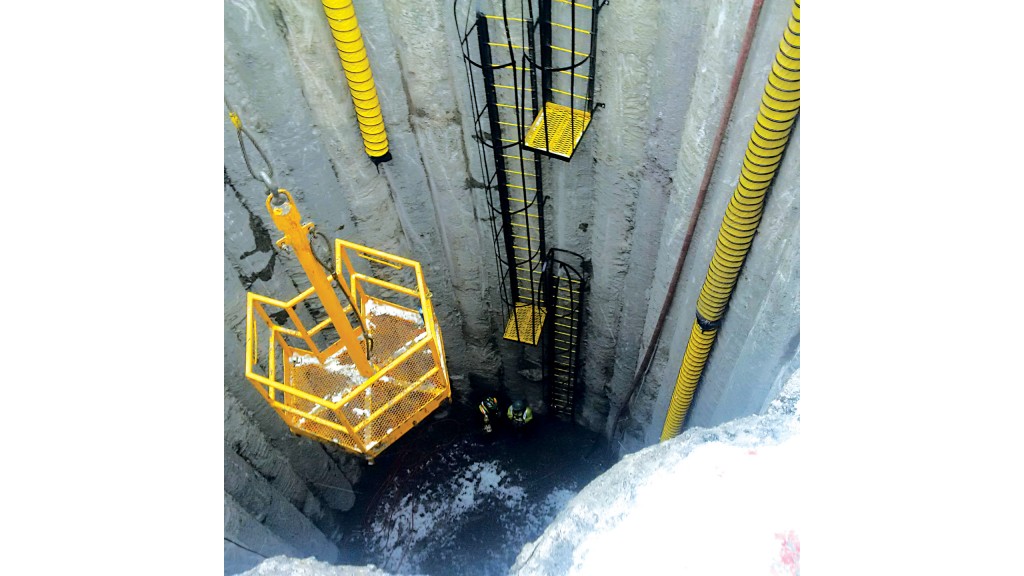Going deep in the nation’s capital
A difficult sewer design in a challenging location near the historic Rideau Canal required many safety and planning considerations by Ottawa’s Greenbelt Construction

Gilmour Street, located south-southeast of downtown Ottawa, runs through the area of the nation's capital called Centretown. It's mostly residential with some businesses mixed in, and is situated between the Ottawa River and the historic Rideau Canal.
The area is somewhat flood prone, a problem that has been evident for decades - the city received hundreds of reports of flooded basements in the area over the past 30 years. To alleviate these issues, the city undertook an environmental assessment in 2006; the process found numerous ways in which infrastructure could be updated to help reduce the potential for flooding.
One of the key points of that project included construction of a new trunk sewer along the eastern end of Gilmour Street. A stretch running three blocks from Elgin Street, a busy north-south corridor, and the Queen Elizabeth Driveway, another busy route that runs along the Rideau Canal, was determined to need the new infrastructure to collect flow from smaller pipes and aid in increasing drainage.
While the sewer project itself had its challenges, the big problem came at the east end: connecting the new trunk to a larger, and deeper, existing trunk next to the Queen Elizabeth Driveway. The contractor - Ottawa-based Greenbelt Construction - had to take on a job that was not only difficult, but required plenty of consideration when it came to safety of its employees.
"The contract was to replace the sewers and water main along Gilmour Street; that is a trunk sewer that, at the outlet end, had to tie into an even deeper trunk sewer," explained Darrin Alberty, project manager with Greenbelt. "We had to dig a deep shaft to construct a large manhole, that then would flow into the collector sewer."
Getting the project off the ground quickly and safely
Work began on the contract in spring of 2016 - with a deadline to complete the shaft, the most complicated part of the job, by June, and bonuses attached to the completion date.
"It was very rushed... it was very heavy on the planning and project management side of things," Alberty said. "We wanted to get the project off the ground quickly and safely."
Gilmour Street was chosen as the most direct approach for a new line to connect with the existing sewer at Queen Elizabeth Driveway but the residential area was a challenge for Greenbelt in managing public impact.
"Residents were very concerned from the very get-go, from the time the city started designing this project," he said.
Building a deep sewer line along Gilmour provided a few issues, especially when it came to work occurring close to houses. Alberty said the company had to come up with some shoring solutions to ensure the trench was stable and there was no movement of the land under the houses.
Working in land operated by the National Capital Commission along the Rideau Canal was also part of the challenge. Not only was Queen Elizabeth Driveway affected but there were bicycle paths and other considerations in the area around the waterway.
The deep shaft, however, was the biggest challenge in terms of planning, execution and safety.
"We haven't done many of these shafts - we build drop manholes all the time, but not that deep," Alberty said.
The plan to connect the two sewers was to construct a shaft seven metres in diameter and 15 metres deep as the target of the Elgin trunk line.
"The shaft was used for two reasons. First, we had to use it as a launching point for a small tunnel to get to the collector sewer... and then we constructed a sewer from that collector back to the shaft," Alberty described. "Inside the shaft we built a cast-in-place manhole."
The shaft was constructed as a seven-metre-diameter secant wall, in which caissons were drilled to the 15-metre depth and filled with concrete, leaving a circle of concrete columns. From there, the shaft was dug out.
"We were able to use traditional excavators to get down to a certain level, but then the geometry of those excavators wouldn't work in such a small diameter shaft, so we had to use a different method, using cranes with skip buckets," Alberty described. "We used a small machine at the bottom of the shaft to load the skip bucket, which then would be lifted back up, dumped into a truck and go back down to be reloaded."
Dealing with a 15-metre hole in the ground is a challenge for many reasons, most notably moving workers up and down while keeping them safe and secure in an enclosed space.
"We developed a site-specific health and safety plan, hired third-party consultants to come in and monitor air quality, and had regular health and safety visits," he described. In addition, the company designed its own ladder system to keep employees safe on the way up and down the shaft.
"Because it was a tight spot, we couldn't use a typical scaffold with stairs, so we had to come up with something that would fit into the space," Alberty described.
The answer was a ladder similar to those used in emergency fire escapes on buildings, with a cage of sorts built around it; the intention was that if an employee fell backwards, they would be caught by the ribs. "It was very successful from a safety point of view," Alberty said.
Once the shaft had been completed, Greenbelt tunneled to the existing collector sewer, about five metres, by hand, then cut into the line and built back into the manhole.
"Basically, you can envision that we have this new trunk sewer coming down Gilmour that enters this manhole at an elevation of about seven metres below the surface," he explained. "From there, the water just drops down the manhole another eight metres, and then flows into the collector sewer."
Project helps with planning Combined Sewage Storage Tunnel for Ottawa
In the end, the project was completed on time and safely, Alberty noted. It also proved to be somewhat of a dress rehearsal for a new challenge.
Ottawa is in the midst of constructing the Combined Sewage Storage Tunnel (CSST) project, a $232 million project intended to reduce the amount of sewage overflow into the Ottawa River during storm events. It includes 6.2 kilometres of deep 3-metre tunnels, one north-south and one east-west, along with numerous even deeper shaft structures.
Greenbelt's parent company, Tomlinson, has partnered with Dragadosto build the tunnels, and Greenbelt will be using the knowledge gained from the Gilmour project to complete some of the shaft work.
"I was able to build [the Gilmour shaft] and then see it constructed while we were estimating the CSST," he said. "Those shafts are probably twice as deep - 30-metre deep shafts, and some of them 13 metres in diameter. It really helped, as an estimator and project manager, to see this one underway while bidding that."


